

Field Evaluations: An Inspector’s Point of View ‹ IAEI Magazine. By Scott Humphrey I remember 20 plus years ago working as an electrician at several Boeing facilities in Seattle Washington, and having the State Inspector at the time, David Sher, walk in with his correction book and start pointing out the deficiencies in the various test fixtures and tooling machines that I had just installed.
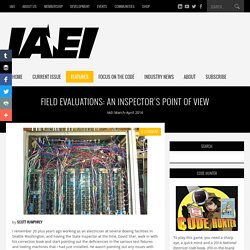
He wasn’t pointing out any issues with my conduit runs or my wiring methods or my overcurrent protection (OCP) at the fused disconnects. He was more interested in looking inside the equipment and checking labels, components and markings. I would usually state my case by saying “But David, this is a one of a kind and only qualified people use this machine.”
David would then start a long sermon regarding the importance of electrical safety. I also remember taking a class on “recognized components,” where I learned the meaning of CE, or Conformité Européene, which is French for “European Conformity.” Electrical Code Now Includes Reconditioned Equipment. To save this item to your list of favorite EE Times content so you can find it later in your Profile page, click the "Save It" button next to the item.
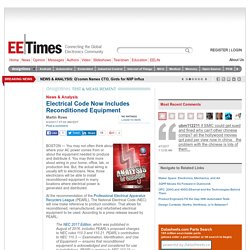
Latest News Semiconductor News Blogs Message Boards Advanced Technology Analog Boards/Buses Electromechanical Embedded Tools FPGAs/PLDs Logic & Interfaces Memory Operating Systems Optoelectronics. Type of Products Requiring NRTL Approval. Nationally Recognized Testing Laboratories (NRTLs) Nrtls. Nationally Recognized Testing Laboratories (NRTLs) What is an NRTL. How do I know a product requires NRTL approval. Is the CE mark accepted by OSHA? Are product manufacturers or suppliers legally required to have products tested and certified by an NRTL? Does OSHA accepts alternates to NRTL approval of products? NRTL Follow-up Inspections at Manufacturing Facilities. Professional Practice content from Fire Protection Engineering. If one walks into a local diner and asks for directions to the nearest post office, they will get lots of suggestions.
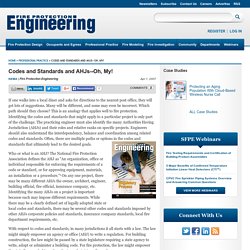
Many will be different, and some may even be incorrect. Which path should they choose? This is an analogy that applies well to fire protection. Identifying the codes and standards that might apply to a particular project is only part of the challenge. The practicing engineer must also identify the many Authorities Having Jurisdiction (AHJs) and their roles and relative ranks on specific projects. Who or what is an AHJ? With respect to codes and standards, in many jurisdictions it all starts with a law. Building codes and fire codes both require certain features of fire prevention and fire protection. Standards contain requirements concerning the application, design, installation and location of the fire protection systems or features required by the codes. Where a building or fire code requires sprinklers, there is an expectation that they will suppress a fire. Directives and laws in America - Pilz - DE. USAThe legal basis in the USA can be seen as a mix of product standards, fire codes (NFPA), electrical codes (NEC) and national laws.
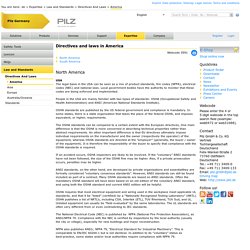
Local government bodies have the authority to monitor that these codes are being enforced and implemented. People in the USA are mainly familiar with two types of standards: OSHA (Occupational Safety and Health Administration) and ANSI (American National Standards Institute). OSHA standards are published by the US federal government and compliance is mandatory. In some states, there is a state organization that takes the place of the federal OSHA, and imposes equivalent, or higher, requirements. The OSHA standards can be compared to a certain extent with the European directives, One main difference is that the OSHA is more concerned in describing technical properties rather than abstract requirements. If an accident occurs, OSHA inspectors are likely to be involved. NFPA also publishes ANSI/, NFPA 79, "Electrical Standard for Industrial Machinery”. Codes vs System Standards vs Product Standards. National Institute of Standards and Technology. STANDARDS LINKAGES TO A PERFORMANCE-BASED REGULATORY FRAMEWORK.
Compliance in NA. UL. MyHome @UL : Definitions and Terms. The company or individual who applies to UL for the investigation of a component, product or system.
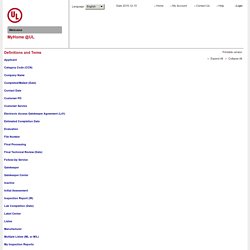
The Applicant, through a legal contract, assumes the financial obligation for the cost of the investigation and Follow-Up Service, and thereby exercises rights to information obtained as a result of the investigation. A code used to identify the grouping of products having common functional and/or design features that facilitates the application of uniform requirements as the basis of UL Listing, Recognition, Classification and Registration services. NEC Adoption Map. Listed devices and NEC. NEC and AHJ.
NEC: Deffinition of Approved. 2017 NEC process. The Role of NEBS Requirements in the Telecom Marketplace. While product safety and reliability are core principles of virtually every manufacturer designing equipment for the telecom industry, the Telcordia Generic Requirements (GRs) that ensure the integrity of such devices and systems are not commonly understood by manufacturers around the globe.
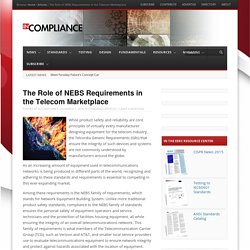
As an increasing amount of equipment used in telecommunications networks is being produced in different parts of the world, recognizing and adhering to these standards and requirements is essential to competing in this ever-expanding market. Among these requirements is the NEBS family of requirements, which stands for Network Equipment Building System.